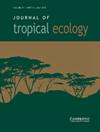嗜盐皮特尼亚真的是一种盐生植物吗?来自发芽和生长实验的证据
IF 1
4区 环境科学与生态学
Q4 ECOLOGY
引用次数: 0
摘要
许多凤梨科植物生长在可能受到盐影响的栖息地。在这方面,嗜盐猪笼草是一个特别有趣的案例,因为它的生长地点位于中美洲海岸悬崖的喷雾区。我们进行了一项实验/观测研究,探索了该物种发生的生理和生态基础。嗜盐P.halophila的发芽与其他自然生长地的同类物种一样,受到盐度增加的影响,但相比之下,幼苗生长受到的影响较小,即使暴露在一半强度的海水中,幼苗生长也保持良好。有趣的是,在整个生长季节记录的原位植物营养浓度表明,这种耐盐能力没有在自然生长地点进行测试——叶片和枝条中的Na+浓度一直很低,与实验室中用蒸馏水浇灌的幼苗相当。我们得出的结论是,嗜盐P.halophila表现出应对中等盐度的生理能力,但潮湿热带生长地的生态条件使这些植物能够完全避免盐胁迫,尽管它们离大海很近。本文章由计算机程序翻译,如有差异,请以英文原文为准。
Is Pitcairnia halophila really a halophyte? Evidence from a germination and growth experiment
Many bromeliads occur in habitats that are potentially affected by salt. Pitcairnia halophila is a particularly interesting case in this context due to its growing sites in the spray zone of coastal cliffs in Central America. We conducted an experimental/observational study that explored the physiological and ecological basis of the occurrence of this species. Germination of P. halophila was as affected by increasing salinity as that of congeneric species from other natural growing sites, but seedling growth was less impaired in comparison and remained positive even at exposure to half-strength seawater. Interestingly, in situ plant nutrient concentrations documented over an entire growing season suggest that this capacity to tolerate salt stress is not tested at the natural growing site – Na+ concentrations were consistently low in leaves and shoots and comparable to those of seedlings watered with distilled water in the laboratory. We conclude that P. halophila shows the physiological ability to deal with medium levels of salinity, but ecological conditions at the humid tropical growing site allow these plants to avoid salt stress entirely in spite of the close proximity to the sea.
求助全文
通过发布文献求助,成功后即可免费获取论文全文。
去求助
来源期刊

Journal of Tropical Ecology
环境科学-生态学
CiteScore
2.10
自引率
0.00%
发文量
44
审稿时长
18-36 weeks
期刊介绍:
Journal of Tropical Ecology aims to address topics of general relevance and significance to tropical ecology. This includes sub-disciplines of ecology, such as conservation biology, evolutionary ecology, marine ecology, microbial ecology, molecular ecology, quantitative ecology, etc. Studies in the field of tropical medicine, specifically where it involves ecological surroundings (e.g., zoonotic or vector-borne disease ecology), are also suitable. We also welcome methods papers, provided that the techniques are well-described and are of broad general utility.
Please keep in mind that studies focused on specific geographic regions or on particular taxa will be better suited to more specialist journals. In order to help the editors make their decision, in your cover letter please address the specific hypothesis your study addresses, and how the results will interest the broad field of tropical ecology. While we will consider purely descriptive studies of outstanding general interest, the case for them should be made in the cover letter.
 求助内容:
求助内容: 应助结果提醒方式:
应助结果提醒方式:


